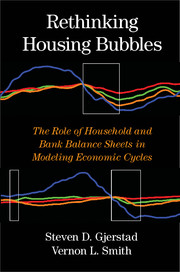 Rethinking Housing Bubbles
Rethinking Housing Bubbles Published online by Cambridge University Press: 05 June 2014
As home prices rose and hunger for high-yield investments grew, Sadek [founder of Quick Loan Funding] found his niche pushing mortgages to borrowers with poor credit. Such subprime home loans grew to $600 billion, or 21 percent, of all U.S. mortgages last year from $160 billion, or 7 percent, in 2001, according to Inside Mortgage Finance, an industry newsletter. Banks drove that growth because they could bundle subprime loans into securities…“I never made a loan that Wall Street wouldn’t buy,” Sadek says. He worked hard to build the business, he says, and the company did nothing illegal…with the support of Citigroup, which funded the loans, he pioneered lending to homebuyers with credit scores of less than 450.
Citigroup spokesman Stephen Cohen said the bank doesn’t comment on its relationships with clients.
“We made most of our money from selling loans to banks,” Sadek says…like many subprime companies, [he] specialized in…thirty-year mortgages that start with lower “teaser” interest rates and ratchet higher after two years.
A key selling point was the 50 percent rise in home prices nationally from 2001 to 2006.
Bob Ivry, Bloomberg News, December 18, 2007Since late 1997, more than $2 billion worth of community reinvestment loans have been packaged and marketed into securities…Every dollar taken off the originator’s books through securitization is a dollar available for new loans…securitization reflects a growing confidence among secondary market investors – many of whom, after all, are under no CRA obligation of their own – in the quality of these loans. I think that it proves we’re on the right track.
John D. Hawke, Jr.; Comptroller of the Currency; May 5, 1999To save this book to your Kindle, first ensure no-reply@cambridge.org is added to your Approved Personal Document E-mail List under your Personal Document Settings on the Manage Your Content and Devices page of your Amazon account. Then enter the ‘name’ part of your Kindle email address below. Find out more about saving to your Kindle.
Note you can select to save to either the @free.kindle.com or @kindle.com variations. ‘@free.kindle.com’ emails are free but can only be saved to your device when it is connected to wi-fi. ‘@kindle.com’ emails can be delivered even when you are not connected to wi-fi, but note that service fees apply.
Find out more about the Kindle Personal Document Service.
To save content items to your account, please confirm that you agree to abide by our usage policies. If this is the first time you use this feature, you will be asked to authorise Cambridge Core to connect with your account. Find out more about saving content to Dropbox.
To save content items to your account, please confirm that you agree to abide by our usage policies. If this is the first time you use this feature, you will be asked to authorise Cambridge Core to connect with your account. Find out more about saving content to Google Drive.